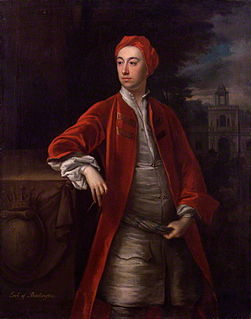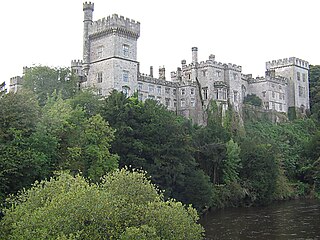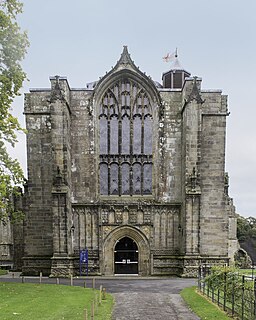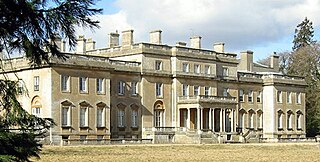
Richard Boyle, 3rd Earl of Burlington and 4th Earl of Cork, was a British architect and noble often called the "Apollo of the Arts" and the "Architect Earl". The son of the 2nd Earl of Burlington and 3rd Earl of Cork, Burlington never took more than a passing interest in politics despite his position as a Privy Counsellor and a member of both the British House of Lords and the Irish House of Lords. His great interests in life were architecture and landscaping, and he is remembered for being a builder and a patron of architects, craftsmen and landscapers, Indeed, he is credited with bringing Palladian architecture to Britain and Ireland. His major projects include Burlington House, Westminster School, Chiswick House and Northwick Park.

Chatsworth House is a stately home in the Derbyshire Dales, 3.5 miles (5.6 km) north-east of Bakewell and 9 miles (14 km) west of Chesterfield, England. The seat of the Duke of Devonshire, it has belonged to the Cavendish family since 1549. It stands on the east bank of the River Derwent, across from hills between the Derwent and Wye valleys, amid parkland backed by wooded hills that rise to heather moorland. The house holds major collections of paintings, furniture, Old Master drawings, neoclassical sculptures and books. Chosen several times as Britain's favourite country house, it is a Grade I listed property from the 17th century, altered in the 18th and 19th centuries. In 2011–2012 it underwent a £14-million restoration. The owner is the Chatsworth House Trust, an independent charitable foundation, on behalf of the Cavendish family.

Duke of Devonshire is a title in the Peerage of England held by members of the Cavendish family. This branch of the Cavendish family has been one of the wealthiest British aristocratic families since the 16th century and has been rivalled in political influence perhaps only by the Marquesses of Salisbury and the Earls of Derby.

Lismore Castle is a castle located in the town of Lismore, County Waterford in the Republic of Ireland. It belonged to the Earls of Desmond, and subsequently to the Cavendish family from 1753. It is currently the Irish home of the Duke of Devonshire. It was largely re-built in the Gothic style during the mid-nineteenth century for The 6th Duke of Devonshire.

Earl of Cork is a title in the Peerage of Ireland, held in conjunction with the Earldom of Orrery since 1753. It was created in 1620 for Richard Boyle, 1st Baron Boyle. He had already been created Lord Boyle, Baron of Youghal, in the County of Cork, in 1616, and was made Viscount of Dungarvan, in the County of Waterford, at the same time he was given the earldom. These titles are also in the Peerage of Ireland.

Richard Boyle, 1st Earl of Burlington, 2nd Earl of Cork was an Anglo-Irish nobleman who served as Lord High Treasurer of Ireland and was a Cavalier.

William Cavendish, 4th Duke of Devonshire,, styled Lord Cavendish before 1729, and Marquess of Hartington between 1729 and 1755, was a British Whig statesman and nobleman who was briefly nominal Prime Minister of Great Britain. He was the first son of William Cavendish, 3rd Duke of Devonshire and his wife, Catherine Hoskins. He is also a great-great-great-great-grandfather of Queen Elizabeth II through the queen's maternal grandmother.

Earl of Burlington is a title that has been created twice, the first time in the Peerage of England in 1664 and the second in the Peerage of the United Kingdom in 1831. Since 1858, Earl of Burlington has been a courtesy title used by the Dukes of Devonshire, traditionally borne by the duke's grandson, who is the eldest son of the duke's eldest son, the Marquess of Hartington.

Baron Londesborough, of Londesborough in the East Riding of the County of York, is a title in the Peerage of the United Kingdom. It was created in 1850 for the diplomat and Whig politician Lord Albert Denison. He was the third son of Henry Conyngham, 1st Marquess Conyngham, and his wife Elizabeth Denison. Born Albert Denison Conyngham, he assumed by royal licence the surname of Denison in lieu of Conyngham in 1849 on inheriting the vast fortune of his maternal uncle William Joseph Denison (1770–1849). Before his elevation to the peerage, Denison had represented Canterbury in Parliament. His eldest son, the second Baron, sat as a Liberal Member of Parliament for Beverley and Scarborough. In 1887 he was created Viscount Raincliffe, of Raincliffe in the North Riding of the County of York, and Earl of Londesborough, in the County of York. These titles were also in the Peerage of the United Kingdom. However, the viscountcy and earldom became extinct on the death of his grandson, the fourth Earl, in 1937.

Burton Constable Hall is a large Elizabethan country house in England, with 18th- and 19th-century interiors and a fine 18th-century cabinet of curiosities. The hall, a Grade I listed building, is set in a park designed by Capability Brown with an area of 300 acres (1.2 km2). It is located 3 miles (5 km) south-east of the village of Skirlaugh in the East Riding of Yorkshire, approximately 9 miles (14 km) north-east of the city of Hull, and has been the home of the Constable family for over 400 years.

Major Henry Somerset, 7th Duke of Beaufort, KG, styled Earl of Glamorgan until 1803 and Marquess of Worcester between 1803 and 1835, was a British peer, soldier, and politician.

Sir George Clifford, 3rd Earl of Cumberland, 13th Baron de Clifford, 13th Lord of Skipton,, was an English peer, naval commander, and courtier of Queen Elizabeth I of England. He was notable at court for his jousting, at the Accession Day Tilts, which were highlights of the year at court. Two famous survivals, his portrait miniature by Nicholas Hilliard and a garniture of Greenwich armour, reflect this important part of his life. In contrast, he neglected his estates in the far north of England, and left a long succession dispute between his heirs.

Baron Clifford is a title in the Peerage of England created by writ of summons on 17 February 1628 for Henry Clifford, Lord Clifford. The title was believed to be held by Lord Clifford's father and descending to Lord Clifford via a writ of acceleration, but it would later be determined that the Clifford title held by that family had passed to a female relative, so the summons of 1628 unintentionally created a new title. Lord Clifford inherited his father's title in 1641, whereupon he sat in the House of Lords as Earl of Cumberland until his death in 1643.

George Cavendish, 1st Earl of Burlington, styled Lord George Cavendish before 1831, was a British nobleman and politician. He built Burlington Arcade.

Devonshire House in Piccadilly, was the London townhouse of the Dukes of Devonshire during the 18th and 19th centuries. Following a fire in 1733 it was rebuilt by William Cavendish, 3rd Duke of Devonshire, in the Palladian style, to designs by William Kent. Completed circa 1740, it stood empty after the First World War and was demolished in 1924.

Charlotte Elizabeth Cavendish, Marchioness of Hartington, 6th Baroness Clifford was the daughter of Richard Boyle, 3rd Earl of Burlington and Lady Dorothy Savile. From 1748 until her death she was married to William Cavendish, Marquess of Hartington, later the 4th Duke of Devonshire and Prime Minister of Great Britain.

Bolton Priory, whose full title is The Priory Church of St Mary and St Cuthbert, Bolton Abbey is a Grade I listed parish church of the Church of England in Bolton Abbey (village), within the Yorkshire Dales National Park in North Yorkshire, England. There has been continuous worship on the site since 1154, when a group of Augustinian canons moved from their original community in nearby village of Embsay and started construction of the present building, which is now situated within a scheduled monument under the Ancient Monuments and Archaeological Areas Act 1979. Despite the loss of most of the Priory buildings during the Dissolution of the Monasteries, the western half of the original nave was preserved so that the local parish could continue its worship there. There is today a full liturgical calendar, in addition to which the Priory hosts the Bolton Priory Concert Series, the Bolton Priory Celebrity Organ Recitals, the Bolton Priory Mystery Play, the Bolton Priory Live Nativity, and the annual St Cuthbert lecture. The Priory is a member of the Greater Churches Network, and welcomes more than 160,000 visitors a year.

Londesborough is a village and civil parish in the East Riding of Yorkshire, England. It is situated approximately 2.5 miles (4 km) north of the market town of Market Weighton. The civil parish is formed by the village of Londesborough and the hamlet of Middlethorpe. According to the 2011 UK census, Londesborough parish had a population of 182, a reduction of one on the 2001 UK census figure.

Tottenham House is a large Grade I listed English country house in the parish of Great Bedwyn, Wiltshire, about five miles southeast of the town of Marlborough. It is separated from the town by Savernake Forest, which is part of the Tottenham Park estate.


















